Ellipsoidal Trajectory Optimization for Minimizing Latency and Data Transmission Energy in UAV-Assisted MEC Using Deep Reinforcement Learning
Abstract
:1. Introduction
- A UAV–MEC system is investigated, where multiple UAVs are used as flying MEC servers to provide computing services to the associated MDs. Each MD has computation-intensive tasks to offload to the UAV–MEC server. The primary objective is to reduce the weighted sum of the total data transmission latency and energy consumption of MDs by optimizing the position, size, and shape of ellipsoidal trajectories for the UAV–MEC servers.
- A Markov decision process (MDP) is formulated for this optimization problem. Then, a DQN-based ellipsoidal trajectory optimization (DETO) is proposed, to optimize the center position, major radius, minor radius, and rotation angle of the ellipsoidal trajectories for the UAV–MEC servers. Additionally, DETO also optimizes the associations between MDs and UAV–MEC servers.
- The Geolife dataset [40], providing user position data, is used for conducting extensive simulations. According to the simulation findings, the proposed model performs better than other baseline approaches, including the greedy algorithm and genetic algorithm (GA), in terms of different numbers of MDs, different numbers of task request rates, and different numbers of UAVs.
2. Related Work
2.1. Optimal Placement of Static UAVs
2.2. Optimal Placement of Mobile UAVs
2.3. Optimal Placement of UAVs Using RL Techniques
2.4. Energy Efficiency and Energy Management with the RL Technique
3. System Model
3.1. Equations of the UAVs Ellipsoidal Movement
3.2. Air-to-Ground Path Loss Model
- represents the portion of the total land area occupied by buildings.
- quantifies the average density of buildings per unit area, measured in terms of the number of buildings per square kilometer.
- is a scale parameter that illustrates the distribution of building heights, using the Rayleigh probability density function.
4. Problem Formulation
5. Proposed Algorithm
5.1. Markov Decision Process Formulation
5.2. DQN-Based Ellipsoidal Trajectory Optimization
| Algorithm 1 DQN-based ellipsoidal trajectory optimization (DETO) |
Input: Initial center position, radius, rotation angle of the ellipsoidal trajectory of each UAV–MEC server Output: Optimal center position, radius, rotation angle of the ellipsoidal trajectory to minimize the system objective
|
6. Performance Evaluation
6.1. Training Efficiency of the DETO Scheme
6.2. Performance Comparison between DETO and Other Baselines
- GA-based ellipsoidal trajectory optimization (GAETO): A rank-based genetic algorithm is employed to find a solution for ellipsoidal trajectory optimization, where each solution is a vector representation of real numbers. The initial population is generated randomly, and the fitness function is calculated using the reciprocal value of the system objective for each individual solution. Lower fitness values are given to higher ranks and have a higher chance of being selected as parents. Then, new solutions are generated by applying crossover and mutation, and the best solution is recorded. This procedure repeats for a given number of generations.
- Greedy: In this setup, each UAV’s center position is chosen from the cluster center. The major radius of each UAV is equal to one half of the distance along the x-axis between its center and its farthest associated user, while the minor radius is equal to one half of the distance along the y-axis between its center and its farthest associated user. The rotation angle is set to .
6.2.1. Effects of Different Numbers of MDs
6.2.2. Effects of Different Numbers of Task Requests
6.2.3. Effects of Different Numbers of UAVs
7. Conclusions
Author Contributions
Funding
Institutional Review Board Statement
Informed Consent Statement
Data Availability Statement
Conflicts of Interest
References
- Grubert, J.; Langlotz, T.; Zollmann, S.; Regenbrecht, H. Towards pervasive augmented reality: Context-awareness in augmented reality. IEEE Trans. Vis. Comput. Graph. 2016, 23, 1706–1724. [Google Scholar] [CrossRef] [PubMed]
- Chen, M.; Saad, W.; Yin, C.; Debbah, M. Data correlation-aware resource management in wireless virtual reality (VR): An echo state transfer learning approach. IEEE Trans. Commun. 2019, 67, 4267–4280. [Google Scholar] [CrossRef]
- Zhang, Y.; Wang, J.; Wang, X.; Dolan, J.M. Road-segmentation-based curb detection method for self-driving via a 3D-LiDAR sensor. IEEE Trans. Intell. Transp. Syst. 2018, 19, 3981–3991. [Google Scholar] [CrossRef]
- Ananthanarayanan, G.; Bahl, P.; Bodík, P.; Chintalapudi, K.; Philipose, M.; Ravindranath, L.; Sinha, S. Real-time video analytics: The killer app for edge computing. Computer 2017, 50, 58–67. [Google Scholar] [CrossRef]
- Soh, J.O.; Tan, B.C. Mobile gaming. Commun. ACM 2008, 51, 35–39. [Google Scholar] [CrossRef]
- Elgendy, I.A.; Meshoul, S.; Hammad, M. Joint Task Offloading, Resource Allocation, and Load-Balancing Optimization in Multi-UAV-Aided MEC Systems. Appl. Sci. 2023, 13, 2625. [Google Scholar] [CrossRef]
- Kim, Y.G.; Kong, J.; Chung, S.W. A survey on recent OS-level energy management techniques for mobile processing units. IEEE Trans. Parallel Distrib. Syst. 2018, 29, 2388–2401. [Google Scholar] [CrossRef]
- Han, W.; Su, J.; Lv, S.; Zhang, P.; Li, X. Task Offloading Strategies for Cloud-Side Cooperation in Compute-Intensive Scenarios Based on Edge Computing. In Proceedings of the 2022 21st International Symposium on Communications and Information Technologies (ISCIT), Xi’an, China, 27–30 September 2022; pp. 148–153. [Google Scholar]
- Mao, Y.; You, C.; Zhang, J.; Huang, K.; Letaief, K.B. A survey on mobile edge computing: The communication perspective. IEEE Commun. Surv. Tutorials 2017, 19, 2322–2358. [Google Scholar] [CrossRef]
- Abbas, N.; Zhang, Y.; Taherkordi, A.; Skeie, T. Mobile edge computing: A survey. IEEE Internet Things J. 2018, 5, 450–465. [Google Scholar] [CrossRef]
- Djigal, H.; Xu, J.; Liu, L.; Zhang, Y. Machine and deep learning for resource allocation in multi-access edge computing: A survey. IEEE Commun. Surv. Tutorials 2022, 24, 2449–2494. [Google Scholar] [CrossRef]
- Yang, J.; Yuan, Q.; Chen, S.; He, H.; Jiang, X.; Tan, X. Cooperative Task Offloading for Mobile Edge Computing Based on Multi-Agent Deep Reinforcement Learning. IEEE Trans. Netw. Serv. Manag. 2023, 20, 3205–3219. [Google Scholar] [CrossRef]
- Zhang, K.; Gui, X.; Ren, D.; Li, D. Energy–latency tradeoff for computation offloading in UAV-assisted multiaccess edge computing system. IEEE Internet Things J. 2020, 8, 6709–6719. [Google Scholar] [CrossRef]
- Kar, B.; Yahya, W.; Lin, Y.D.; Ali, A. Offloading using traditional optimization and machine learning in federated cloud-edge-fog systems: A survey. IEEE Commun. Surv. Tutorials 2023, 25, 1199–1226. [Google Scholar] [CrossRef]
- Yu, Z.; Gong, Y.; Gong, S.; Guo, Y. Joint task offloading and resource allocation in UAV-enabled mobile edge computing. IEEE Internet Things J. 2020, 7, 3147–3159. [Google Scholar] [CrossRef]
- Zhou, Y.; Pan, C.; Yeoh, P.L.; Wang, K.; Elkashlan, M.; Vucetic, B.; Li, Y. Secure communications for UAV-enabled mobile edge computing systems. IEEE Trans. Commun. 2019, 68, 376–388. [Google Scholar] [CrossRef]
- Yang, Z.; Pan, C.; Wang, K.; Shikh-Bahaei, M. Energy efficient resource allocation in UAV-enabled mobile edge computing networks. IEEE Trans. Wirel. Commun. 2019, 18, 4576–4589. [Google Scholar] [CrossRef]
- Zhan, C.; Hu, H.; Liu, Z.; Wang, Z.; Mao, S. Multi-UAV-enabled mobile-edge computing for time-constrained IoT applications. IEEE Internet Things J. 2021, 8, 15553–15567. [Google Scholar] [CrossRef]
- Košmerl, J.; Vilhar, A. Base stations placement optimization in wireless networks for emergency communications. In Proceedings of the 2014 IEEE International Conference on Communications Workshops (ICC), Sydney, NSW, Australia, 10–14 June 2014; pp. 200–205. [Google Scholar]
- Moon, I.; Dung, L.T.; Kim, T. Optimal 3D placement of UAV-BS for maximum coverage subject to user priorities and distributions. Electronics 2022, 11, 1036. [Google Scholar] [CrossRef]
- Lyu, J.; Zeng, Y.; Zhang, R.; Lim, T.J. Placement optimization of UAV-mounted mobile base stations. IEEE Commun. Lett. 2016, 21, 604–607. [Google Scholar] [CrossRef]
- Valiulahi, I.; Masouros, C. Multi-UAV deployment for throughput maximization in the presence of co-channel interference. IEEE Internet Things J. 2020, 8, 3605–3618. [Google Scholar] [CrossRef]
- Lyu, J.; Zeng, Y.; Zhang, R. Cyclical multiple access in UAV-aided communications: A throughput-delay tradeoff. IEEE Wirel. Commun. Lett. 2016, 5, 600–603. [Google Scholar] [CrossRef]
- Zeng, Y.; Zhang, R.; Lim, T.J. Throughput maximization for UAV-enabled mobile relaying systems. IEEE Trans. Commun. 2016, 64, 4983–4996. [Google Scholar] [CrossRef]
- Zeng, Y.; Zhang, R. Energy-efficient UAV communication with trajectory optimization. IEEE Trans. Wirel. Commun. 2017, 16, 3747–3760. [Google Scholar] [CrossRef]
- Yu, P.; Guo, J.; Huo, Y.; Shi, X.; Wu, J.; Ding, Y. Three-dimensional aerial base station location for sudden traffic with deep reinforcement learning in 5G mmWave networks. Int. J. Distrib. Sens. Networks 2020, 16, 1550147720926374. [Google Scholar] [CrossRef]
- Liu, X.; Liu, Y.; Chen, Y. Reinforcement learning in multiple-UAV networks: Deployment and movement design. IEEE Trans. Veh. Technol. 2019, 68, 8036–8049. [Google Scholar] [CrossRef]
- Zhao, N.; Ye, Z.; Pei, Y.; Liang, Y.C.; Niyato, D. Multi-agent deep reinforcement learning for task offloading in UAV-assisted mobile edge computing. IEEE Trans. Wirel. Commun. 2022, 21, 6949–6960. [Google Scholar] [CrossRef]
- Wang, L.; Wang, K.; Pan, C.; Xu, W.; Aslam, N.; Nallanathan, A. Deep reinforcement learning based dynamic trajectory control for UAV-assisted mobile edge computing. IEEE Trans. Mob. Comput. 2021, 21, 3536–3550. [Google Scholar] [CrossRef]
- Wang, Y.; Ru, Z.-Y.; Wang, K.; Huang, P.-Q. Joint Deployment and Task Scheduling Optimization for Large-Scale Mobile Users in Multi-UAV-Enabled Mobile Edge Computing. IEEE Trans. Cybern. 2020, 50, 3984–3997. [Google Scholar] [CrossRef]
- Kelleher, J.D. Deep Learning; MIT Press: Cambridge, MA, USA, 2019. [Google Scholar]
- Arulkumaran, K.; Deisenroth, M.P.; Brundage, M.; Bharath, A.A. Deep reinforcement learning: A brief survey. IEEE Signal Process. Mag. 2017, 34, 26–38. [Google Scholar] [CrossRef]
- Sutton, R.S.; Barto, A.G. Reinforcement Learning: An Introduction; MIT Press: Cambridge, MA, USA, 2018. [Google Scholar]
- Kaur, A.; Kumar, K. Energy-efficient resource allocation in cognitive radio networks under cooperative multi-agent model-free reinforcement learning schemes. IEEE Trans. Netw. Serv. Manag. 2020, 17, 1337–1348. [Google Scholar] [CrossRef]
- Zheng, K.; Jia, X.; Chi, K.; Liu, X. DDPG-based joint time and energy management in ambient backscatter-assisted hybrid underlay CRNs. IEEE Trans. Commun. 2022, 71, 441–456. [Google Scholar] [CrossRef]
- Lee, G.; Jung, M.; Kasgari, A.T.Z.; Saad, W.; Bennis, M. Deep reinforcement learning for energy-efficient networking with reconfigurable intelligent surfaces. In Proceedings of the ICC 2020—2020 IEEE International Conference on Communications (ICC), Dublin, Ireland, 7–11 June 2020; pp. 1–6. [Google Scholar]
- Savaglio, C.; Pace, P.; Aloi, G.; Liotta, A.; Fortino, G. Lightweight reinforcement learning for energy efficient communications in wireless sensor networks. IEEE Access 2019, 7, 29355–29364. [Google Scholar] [CrossRef]
- Zhu, B.; Bedeer, E.; Nguyen, H.H.; Barton, R.; Henry, J. UAV trajectory planning in wireless sensor networks for energy consumption minimization by deep reinforcement learning. IEEE Trans. Veh. Technol. 2021, 70, 9540–9554. [Google Scholar] [CrossRef]
- Akter, S.; Dao, T.N.; Yoon, S. Time-constrained task allocation and worker routing in mobile crowd-sensing using a decomposition technique and deep Q-learning. IEEE Access 2021, 9, 95808–95822. [Google Scholar] [CrossRef]
- Zheng, Y.; Xie, X.; Ma, W. Geolife: A collaborative social networking service among user, location and trajectory. IEEE Data Eng. Bull. 2010, 33, 32–39. [Google Scholar]
- Belmonte, L.M.; García, A.S.; Morales, R.; de la Vara, J.L.; López de la Rosa, F.; Fernández-Caballero, A. Feeling of safety and comfort towards a socially assistive unmanned aerial vehicle that monitors people in a virtual home. Sensors 2021, 21, 908. [Google Scholar] [CrossRef]
- Chen, Y.; Li, N.; Zhong, X.; Xie, W. Joint trajectory and scheduling optimization for the mobile UAV aerial base station: A fairness version. Appl. Sci. 2019, 9, 3101. [Google Scholar] [CrossRef]
- Chen, X.; Yang, Z.; Zhao, N.; Chen, Y.; Wang, J.; Ding, Z.; Yu, F.R. Secure transmission via power allocation in NOMA-UAV networks with circular trajectory. IEEE Trans. Veh. Technol. 2020, 69, 10033–10045. [Google Scholar] [CrossRef]
- Al-Hourani, A.; Kandeepan, S.; Lardner, S. Optimal LAP altitude for maximum coverage. IEEE Wirel. Commun. Lett. 2014, 3, 569–572. [Google Scholar] [CrossRef]
- Al-Hourani, A.; Kandeepan, S.; Jamalipour, A. Modeling air-to-ground path loss for low altitude platforms in urban environments. In Proceedings of the 2014 IEEE Global Communications Conference, Austin, TX, USA, 8–12 December 2014; pp. 2898–2904. [Google Scholar]
- Li, X.; Zhou, L.; Sun, Y.; Ulziinyam, B. Multi-task offloading scheme for UAV-enabled fog computing networks. Eurasip J. Wirel. Commun. Netw. 2020, 2020, 230. [Google Scholar] [CrossRef]
- Puterman, M.L. Markov Decision Processes: Discrete Stochastic Dynamic Programming; John Wiley & Sons: Hoboken, NJ, USA, 2014. [Google Scholar]
- Watkins, C.J.C.H.; Dayan, P. Q-learning. Mach. Learn. 1992, 8, 279–292. [Google Scholar] [CrossRef]
- Mnih, V.; Kavukcuoglu, K.; Silver, D.; Rusu, A.A.; Veness, J.; Bellemare, M.G.; Graves, A.; Riedmiller, M.; Fidjeland, A.K.; Ostrovski, G.; et al. Human-level control through deep reinforcement learning. Nature 2015, 518, 529–533. [Google Scholar] [CrossRef] [PubMed]
- Lyu, L.; Zeng, F.; Xiao, Z.; Zhang, C.; Jiang, H.; Havyarimana, V. Computation bits maximization in uav-enabled mobile-edge computing system. IEEE Internet Things J. 2021, 9, 10640–10651. [Google Scholar] [CrossRef]
- Zhang, J.; Zeng, Y.; Zhang, R. Spectrum and energy efficiency maximization in UAV-enabled mobile relaying. In Proceedings of the 2017 IEEE International Conference on Communications (ICC), Paris, France, 21–25 May 2017; pp. 1–6. [Google Scholar]
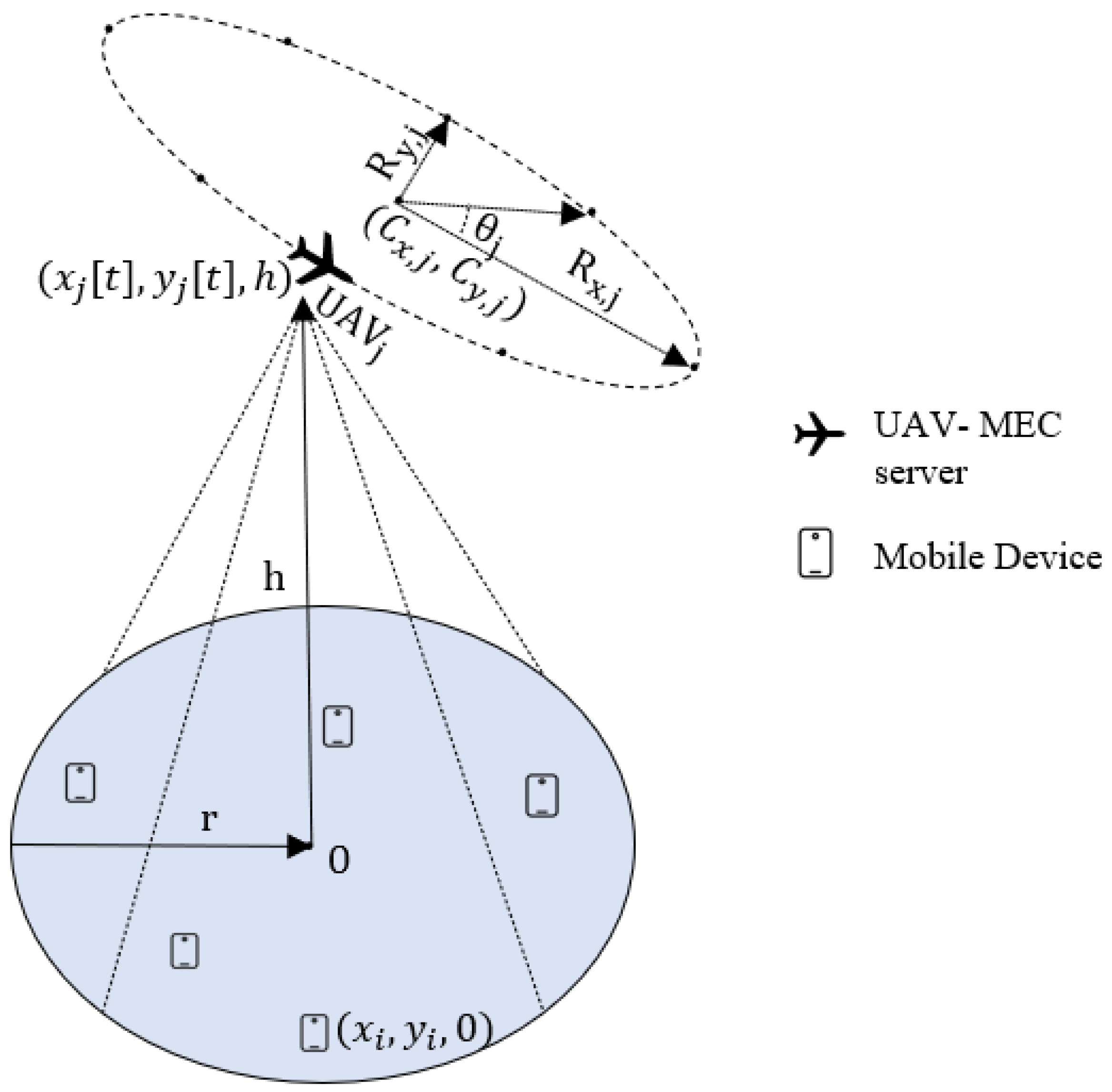

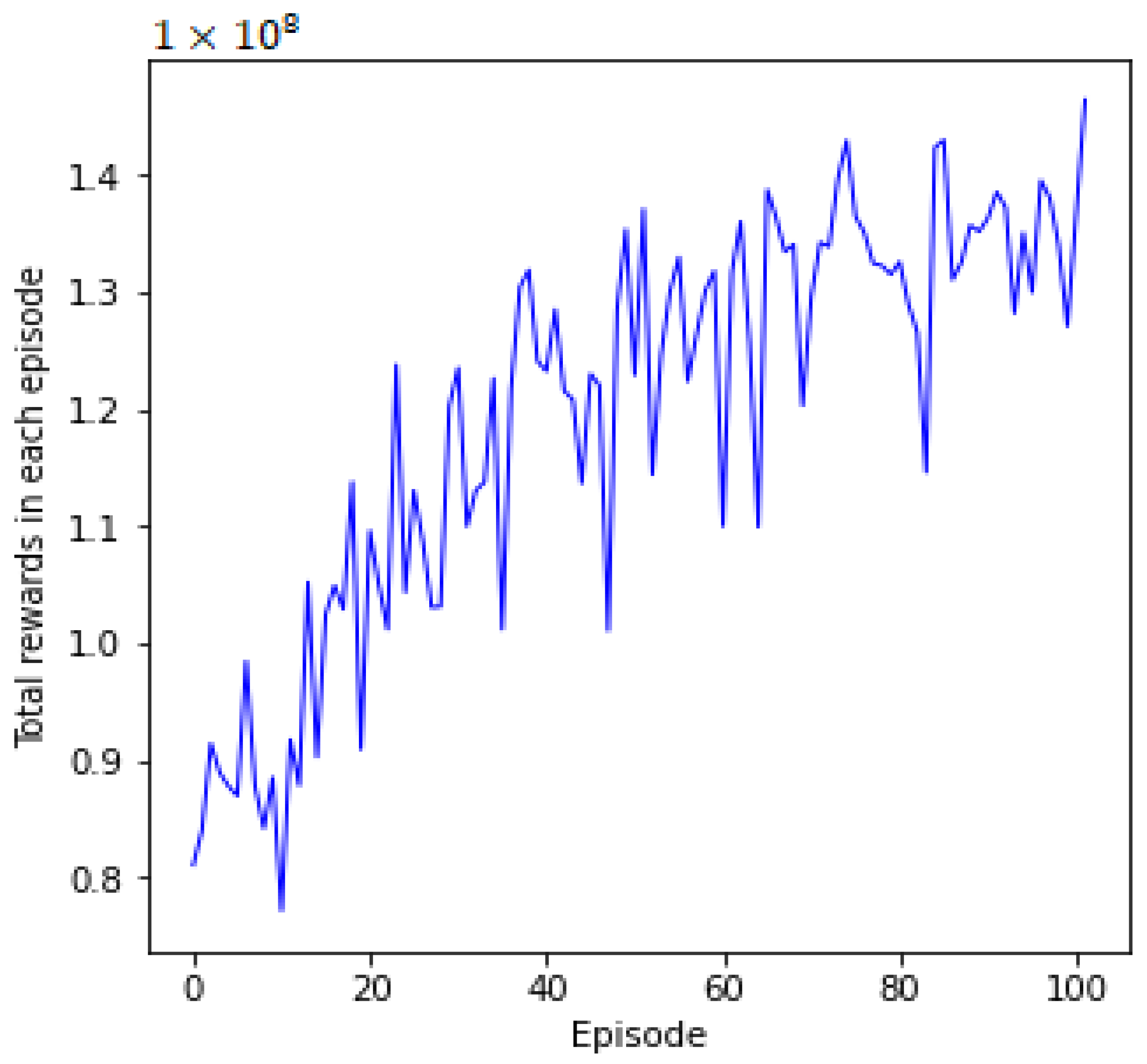

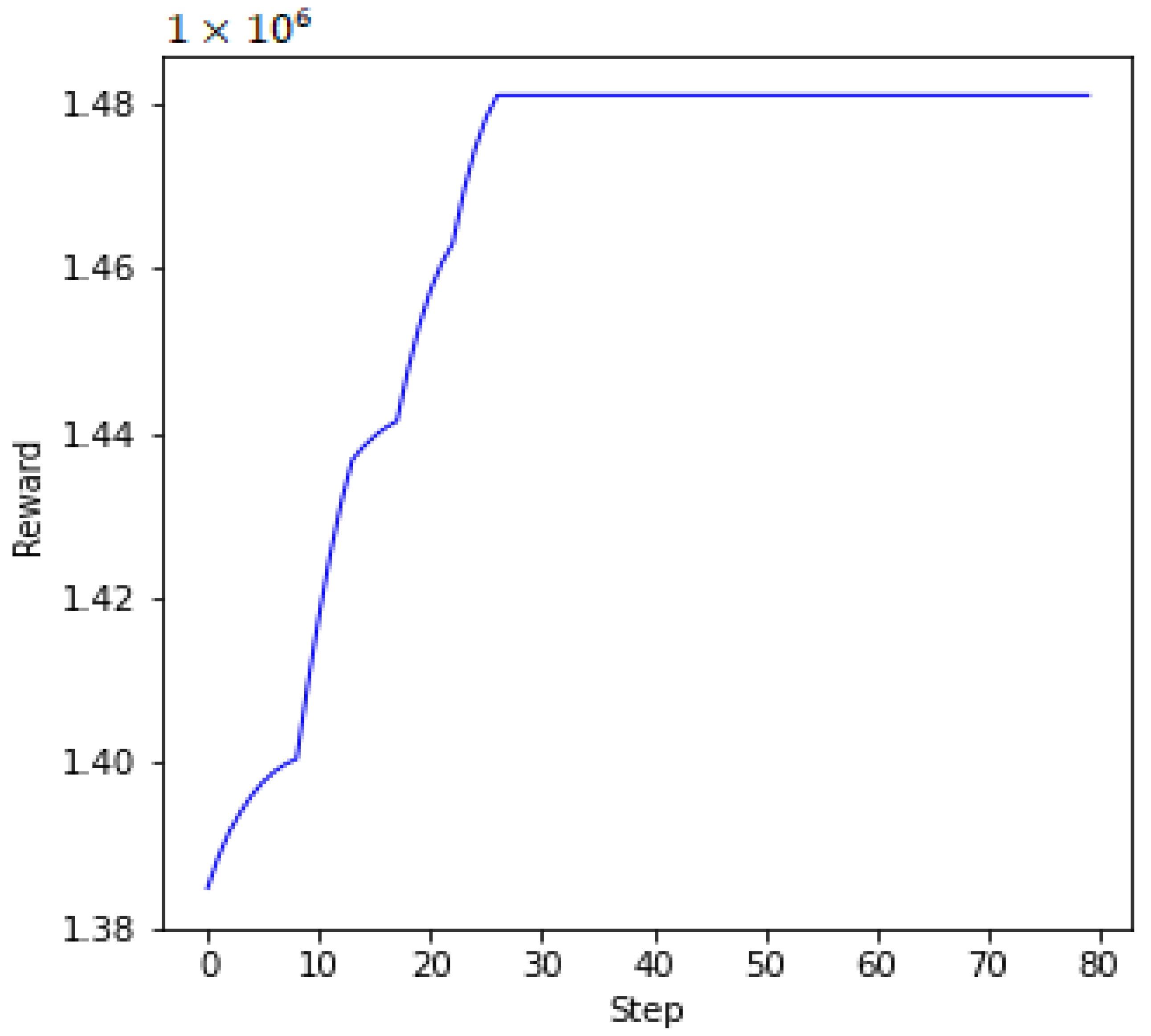

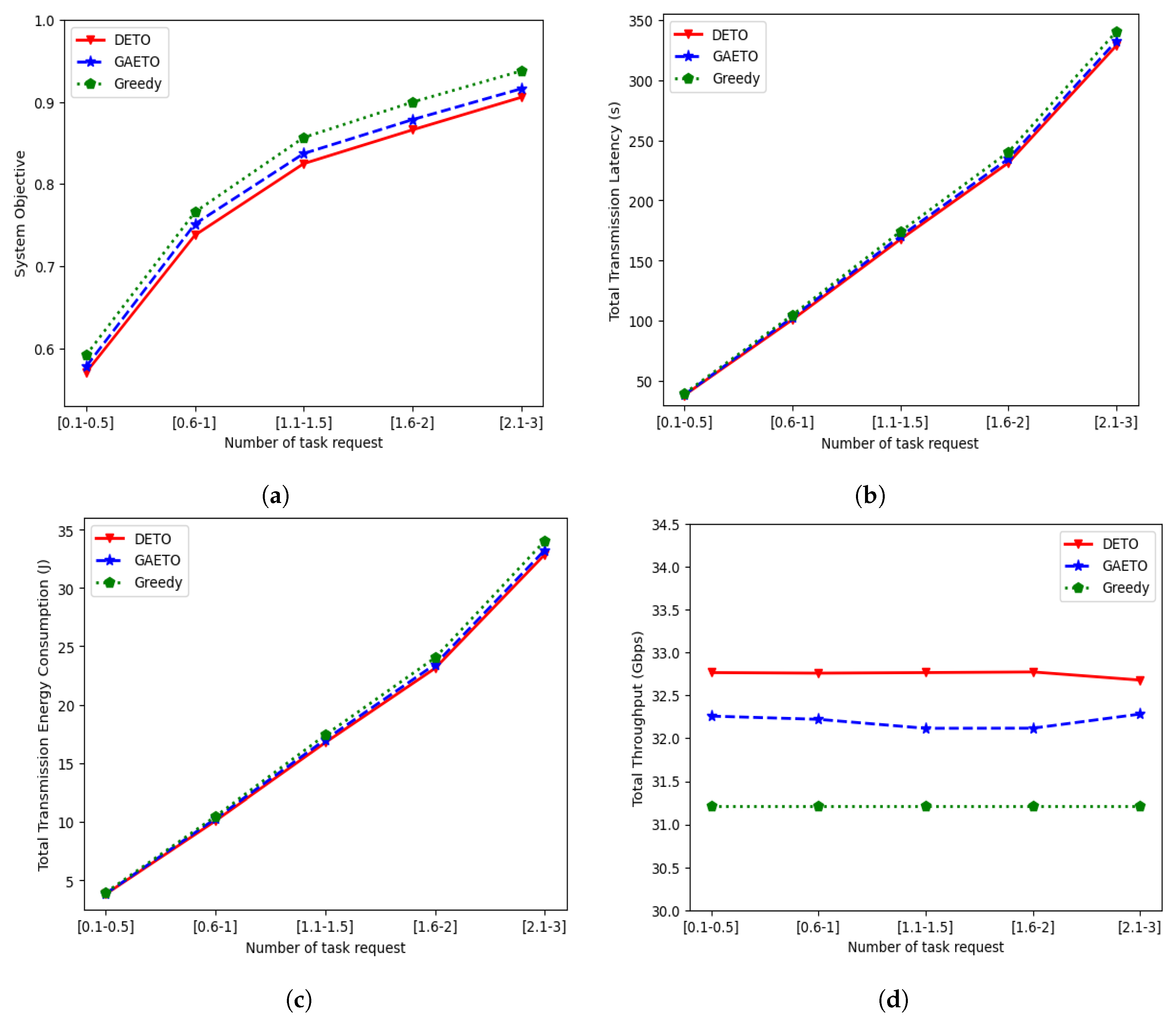
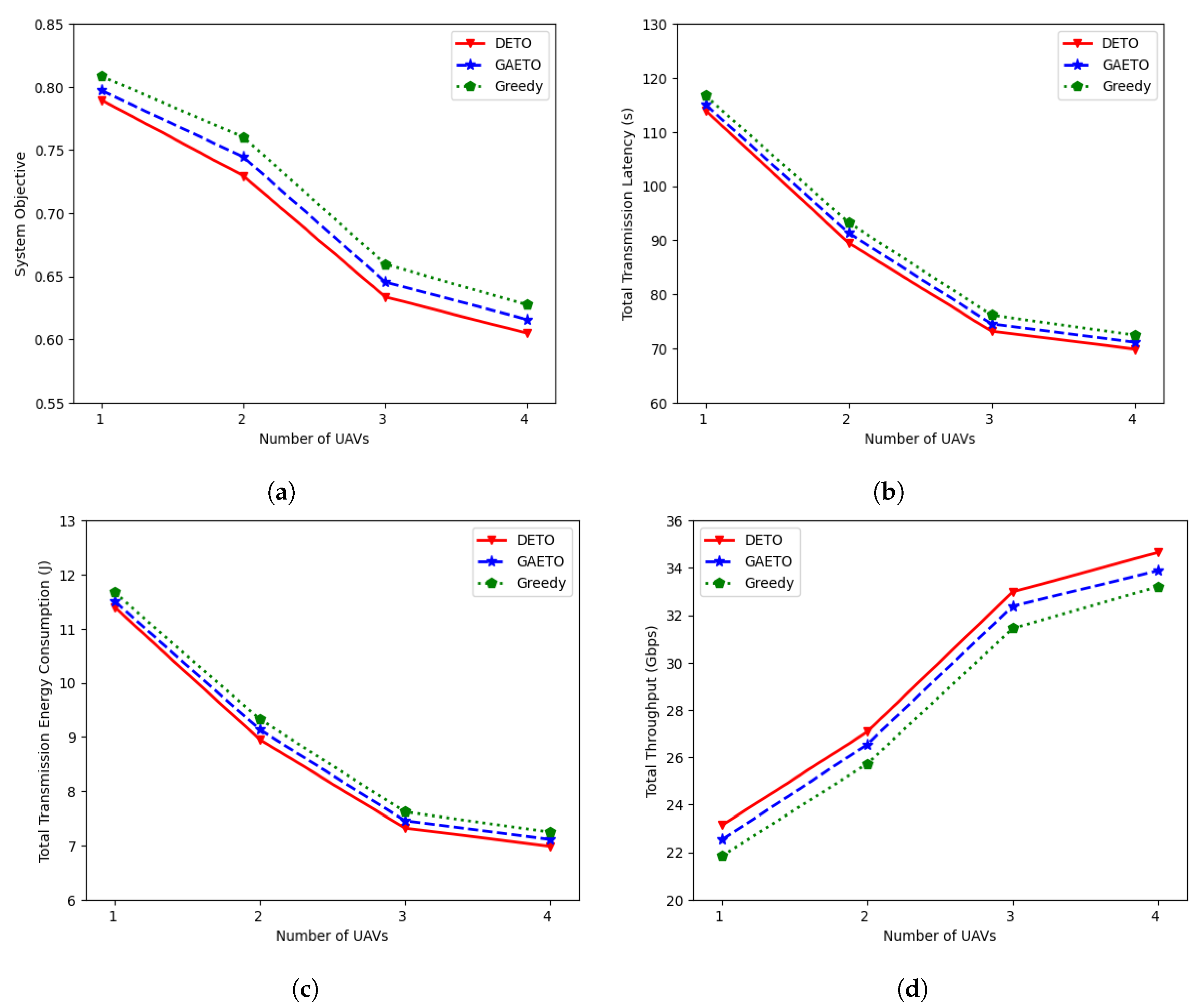
| Notation | Description |
|---|---|
| Number and set of MDs | |
| Number and set of UAVs | |
| User association between the ith MD and the jth UAV–MEC server | |
| Task request rate of MD i | |
| Input data size (in bytes) of each task of MD i | |
| Minimal, maximal values of task request | |
| Minimal, maximal values for the task data size | |
| Coordinates of the ith MD | |
| Coordinates of the jth UAV–MEC server | |
| T | Cycle period of UAV–MEC server’s ellipsoidal trajectory |
| X-coordinate center of the jth UAV–MEC server’s ellipsoidal path | |
| Y-coordinate center of the jth UAV–MEC server’s ellipsoidal path | |
| Major radius of the jth UAV–MEC server’s ellipsoidal path | |
| Minor radius of the jth UAV–MEC server’s ellipsoidal path | |
| Rotation angle in the jth UAV–MEC server’s ellipsoidal path | |
| Ground distance | |
| 3D distance between MD i and UAV–MEC server j | |
| Path loss of line-of-sight link | |
| Path loss of non-line-of-sight link | |
| Probability of line-of-sight link | |
| Probability of non-line-of-sight link | |
| Propagation environment constants | |
| c | Speed of light |
| f | Carrier frequency |
| , | Additional loss for LoS and NLoS propagation modes |
| Elevation angle between MD and UAV–MEC server | |
| Path loss between MD i and UAV–MEC server j | |
| h | Height of the UAV–MEC server |
| Transmit power of the MD | |
| Noise power | |
| B | Channel bandwidth |
| Signal-to-noise ratio between MD i and UAV–MEC server j | |
| Average data transmission rate | |
| Data transmission latency between MD i and UAV–MEC server j | |
| Energy consumption for transferring data from MD i to UAV–MEC server j | |
| Total data transmission latency of MDs connected to UAV–MEC server j | |
| Total transmission energy consumption of MDs connected to UAV–MEC server j for offloading task request per second | |
| Weighted sum of transmission latency and transmission energy consumption | |
| Relative weights of transmission latency and transmission energy consumption of MDs connected to UAV–MEC server j |
| Parameter | Symbol | Value | Unit |
|---|---|---|---|
| Size of the area | - | m | |
| Number of MDs | M | - | |
| Number of UAVs | N | - | |
| Task offload request rate | [] | task/s | |
| Task size | ł | [] | MB |
| Height of UAV | h | 100 [15,50] | m |
| Range of major radius | [] [43,51] | m | |
| Range of minor radius | [] | m | |
| Range of rotation angle | [0, 360] | ||
| Path loss parameter | a | - | |
| Path loss parameter | b | - | |
| Path loss parameter | 1 | - | |
| Path loss parameter | 20 | - | |
| Channel bandwidth | B | 20 | MHz |
| Transmit power of MD | 20 | dBm | |
| Noise power | dBm | ||
| The carrier frequency | f | 2 | GHz |
| The speed of light | c | 299,792,458 | - |
| weight | - |
| Parameter | Value |
|---|---|
| Number of episodes | 100 |
| Time steps | 80 |
| Learning rate | |
| Discount factor | |
| with starting value | 1 |
| with final value | |
| Epsilon decay | 0.9997 |
| Memory size | 2500 |
| Batch size | 32 |
| Optimizer | Adam optimizer |
Disclaimer/Publisher’s Note: The statements, opinions and data contained in all publications are solely those of the individual author(s) and contributor(s) and not of MDPI and/or the editor(s). MDPI and/or the editor(s) disclaim responsibility for any injury to people or property resulting from any ideas, methods, instructions or products referred to in the content. |
© 2023 by the authors. Licensee MDPI, Basel, Switzerland. This article is an open access article distributed under the terms and conditions of the Creative Commons Attribution (CC BY) license (https://creativecommons.org/licenses/by/4.0/).
Share and Cite
Sadia, R.; Akter, S.; Yoon, S. Ellipsoidal Trajectory Optimization for Minimizing Latency and Data Transmission Energy in UAV-Assisted MEC Using Deep Reinforcement Learning. Appl. Sci. 2023, 13, 12136. https://doi.org/10.3390/app132212136
Sadia R, Akter S, Yoon S. Ellipsoidal Trajectory Optimization for Minimizing Latency and Data Transmission Energy in UAV-Assisted MEC Using Deep Reinforcement Learning. Applied Sciences. 2023; 13(22):12136. https://doi.org/10.3390/app132212136
Chicago/Turabian StyleSadia, Rabeya, Shathee Akter, and Seokhoon Yoon. 2023. "Ellipsoidal Trajectory Optimization for Minimizing Latency and Data Transmission Energy in UAV-Assisted MEC Using Deep Reinforcement Learning" Applied Sciences 13, no. 22: 12136. https://doi.org/10.3390/app132212136
APA StyleSadia, R., Akter, S., & Yoon, S. (2023). Ellipsoidal Trajectory Optimization for Minimizing Latency and Data Transmission Energy in UAV-Assisted MEC Using Deep Reinforcement Learning. Applied Sciences, 13(22), 12136. https://doi.org/10.3390/app132212136






